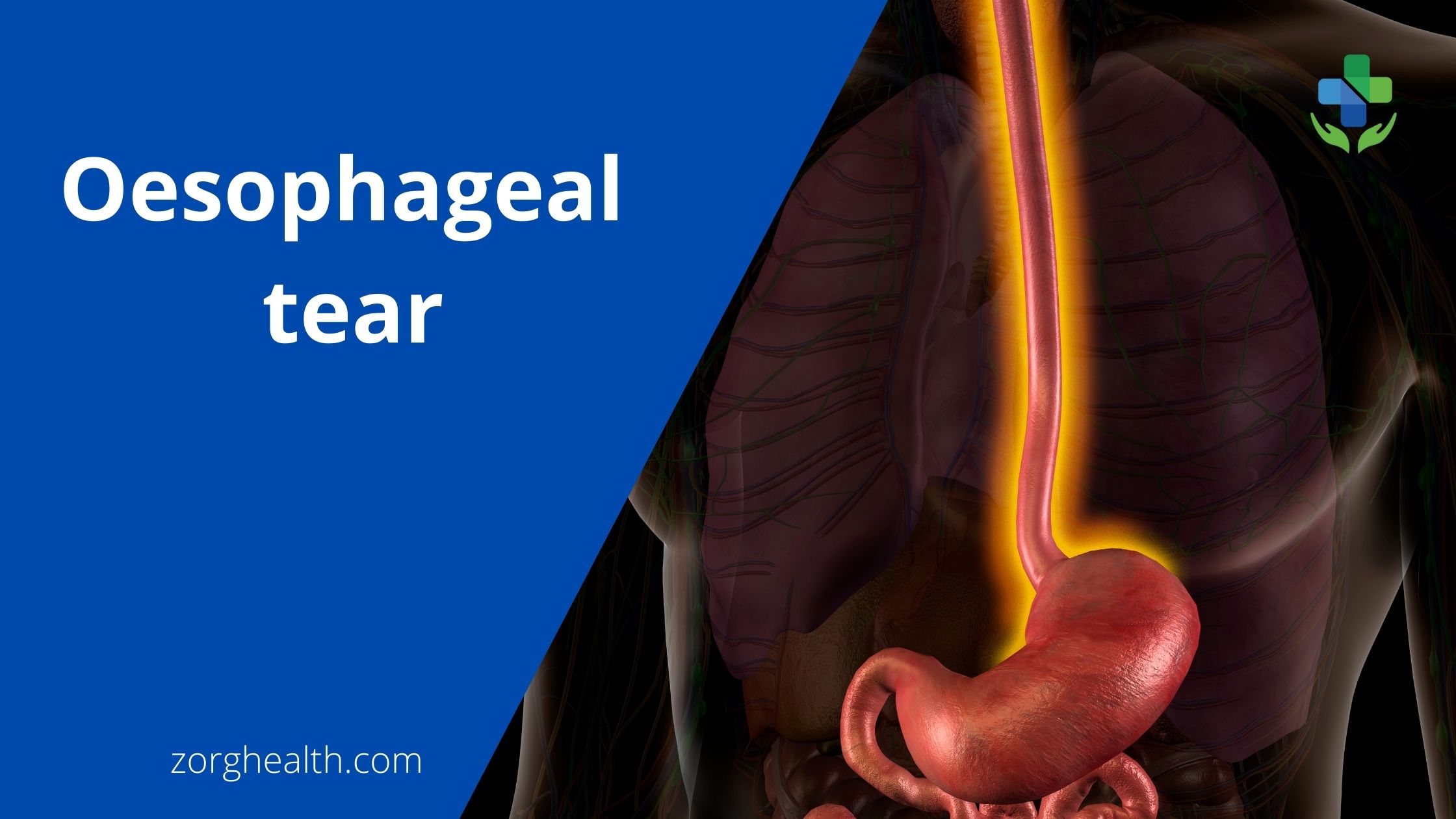The oesophagus is the other name for your food pipe. The oesophagus plays important role in carrying the food to the stomach. Oesophagus is a long organ and along its entire length is surrounded and compressed by various other important structures. Any injury like an oesophageal tear can make someone’s life miserable!

Oesophageal tear TOC
- 1. What is the Oesophagus?
- 2. What is oesophageal perforation?
- 3. What are the reasons for oesophageal perforation?
- 4. What are the symptoms of oesophageal rupture?
- 5. How is oesophageal injury diagnosed?
- 6. What are the consequences/ sequelae/complications of oesophageal rupture?
- 7. How is Oesophageal rupture managed?
What is the Oesophagus?
It is a part of your digestive system and is also known as the gullet. It is a tubular structure that has its own movements of contraction and relaxation. Your food pipe is almost 25 cm long. It starts at the level of your sixth vertebral bone of the neck and goes to the level of the 10th vertebral bone of the thorax or chest. It is a tube that contains both muscle and fibres, because of which we are able to push food into the stomach even when we are lying on the bed. These movements are called peristalsis.
There are 3 areas of the oesophagus which are narrower and are normal constriction of it-
- The first area of narrowing is just at the beginning of the food pipe.
- Second normal constriction is when the largest blood carrying vessel called the “aortic arch” and left bronchus (a division of the windpipe) both cross the oesophagus.
- The third constriction is near the end of the tube when it enters the abdomen by crossing the diaphragm (sheet of muscle that separates the thorax from the abdomen)
Also, your food pipe can be divided into three parts to understand and relate the anatomy. These are cervical, thoracic and abdominal oesophagus.
What is oesophageal perforation?
As mentioned earlier, the oesophagus or food pipe is a long tubular structure. It runs a long course and is housed in three different areas of the body, neck, chest and abdomen. Along its entire course, it is always surrounded, crossed or compressed by different structures and that is why there are more chances of the oesophagus getting injured or involved in diseases.
Oesophageal tear or perforation is one life-threatening situation, and the mortality rate has been reported up to 50%. It’s estimated to be only 0.5 %. The greatest number of perforations have been reported in the intrathoracic segment followed by the intra-cervical segment.
In oesophageal injury, it becomes easy for many bodily secretions to leak and reach places they are not supposed to go. And this spillage causes serious effects and even death.
What are the reasons for oesophageal perforation?
Another anatomical fact of the oesophagus is that it lacks one important layer called a serosal layer. Not having this layer makes food pipes more prone to tear or rupture. According to research and literature, food pipe tear or rupture is more common in males in their sixties. The causes for injury are-
- Sclerotherapy
- Nasogastric tube placement
- Oesophageal stenting
- Frequently done endotracheal intubation
- Impacted foreign bodies
- Procedures are done for acidity or hernia
- Pressure necrosis
- Pneumonectomy
- Vagotomy
- Blast injuries, bullet injuries
- Ingestion injuries from alkalis and acids
- Spontaneous rupture
- Rarely, anterior cervical sp
- Neglected infections
What are the symptoms of oesophageal rupture?
Although immediate diagnosis can be made at the time of iatrogenic (caused by treating person), still the majority of diagnosis of oesophageal rupture is delayed.
Pain is the most commonly encountered symptom. If the perforation is in the cervical segment of the oesophagus, then pain is experienced in the thorax (chest). Thoracic segment perforations lead to radiation of pain in the abdomen. In clinical settings, if the patient had repeated vomiting followed by pain in the thorax or abdomen, particularly after a procedure related to the oesophagus should raise the suspicion of oesophageal perforation or rupture.
Apart from pain sometimes other symptoms like chest pain of varying severity, nausea, vomiting, rapid breathing and fever may be noticed early.
There are a few symptoms that suggest that the space around the thoracic oesophagus is infected (called mediastinitis), like raised body temperature, faster heartbeats, faster respiratory rate, low blood pressure, and low body oxygen or cyanosis.
Another presentation is when after surgery, particularly anterior spine plating or decompression, the patient develops a connection between skin and food pipe and is called an oesophagal-cutaneous fistula. It is such a rare condition that as per literature it has less than 0.1 % incidence, and this makes it very complex to treat as there is not much literature on it.
How is oesophageal injury diagnosed?
Externally connecting injuries can be easily diagnosed as there will be a discharge of blood or mucus from the outer opening. Inner injuries are difficult to diagnose clinically and this is the reason why they are diagnosed very late when a patient presents with serious complications.
The tests performed for diagnosis of oesophageal rupture are-
- CT SCAN- computed tomography can delineate the defect all around with added information on surrounding structures.
- Oesophagoscopy- direct visualisation of the food pipe can also show the site of perforation.
- Contrast oesophagography- this patient is asked to drink some water-based contrast and serial radiographic pictures are taken to notice any spillage outside the tube.
- Gastrografin study- similar to the above-mentioned study except that abdominal pictures is taken in this study.
- Plain radiographs- to detect an air leak or emphysema.
What are the consequences/ sequelae/complications of oesophageal rupture?
Oesophageal rupture can be life-threatening if not treated in time. It can result in spillage of secretions into outer space leading to chemical mediastinitis, necrosis of organs in the surrounding area, emphysema due to air leak, fistula with windpipe (trachea-oesophageal fistula), fistula with skin (esophagi-cutaneous fistula), sepsis, organ failure and death.
How is Oesophageal rupture managed?
Here are a few of the current practices-
- The first important step is to recognise and realise that it’s a life-threatening complication, and the patient should be admitted to proper settings and given intensive care. Admission to ICU, vitals monitoring, keeping patient NPO (nil per oral), broad-spectrum antibiotics, and total parenteral nutrition are all essential steps.
- Feeding tubes- the patient can be put on nasogastric tube feeding. PEG (percutaneous endoscopic gastrostomy), is a procedure by which a surgeon puts a tube from abdominal skin directly into the stomach, bypassing the food pipe. J-tube feeding is when the tube is put directly into the small intestine. These tubes let the patient get nutrition and the same time give rest to the injured area to heal itself.
- Endoscopic procedures- when the patient is stable, and there is time for planning the repair, the endoscopic approach can be tried. In this through camera stent can be placed at the site of perforation, but various failures have been reported like slipping of the stent from its position, leaking of content through the stent etc.
- Debridement- slippage or leaking of gastric fluid into the surrounding leads to necrosis and infection of surrounding tissue, which needs surgical clearance of unhealthy tissue which is called debridement.
- Open surgical approach- recent perforation (less than 24 hours old) shall be considered for any debridement if needed and then repaired. For repair surgeons might choose different types of flaps like muscle or diaphragm. Sometimes tissue glue is used to seal the defect.
- Late cases or badly infected cases are taken for debridement, sealing of defect with stenting and putting a drain pipe.
- Sometimes in case of malignancy or extensive contamination, some segment of the food pipe needs to be removed surgically, and the remaining part is attached directly to pulled up the stomach.
Meanwhile, the patient has been put on feeding tubes for weeks together to let the repaired segment heal. Repairing the oesophageal tear needs a multidisciplinary approach. Surgeons, radiologists, thoracic surgeons, laparoscopic surgeons, intensive care experts, and spinal surgeons all make a team that will provide adequate treatment.
Depending upon the size and type of rupture, surgeons plan different procedures to repair the tear. As these complications are very rare, there are very limited studies on the management of oesophageal rupture. But despite being a life-threatening complication, a team approach or multiple operations and procedures can finally make it possible to repair the oesophageal perforation.
